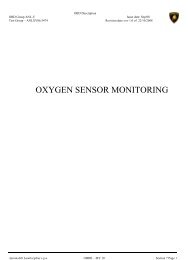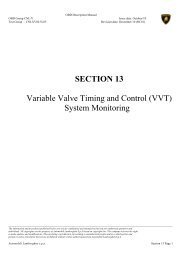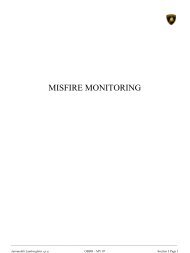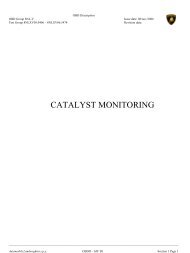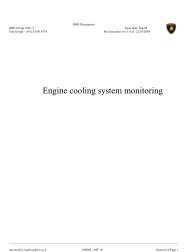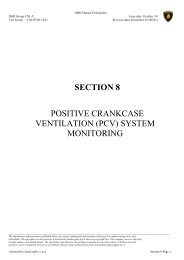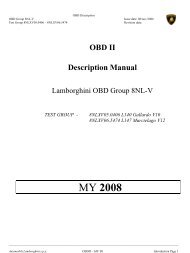Positive crankcase ventilation (pcv) system monitoring - Automobili ...
Positive crankcase ventilation (pcv) system monitoring - Automobili ...
Positive crankcase ventilation (pcv) system monitoring - Automobili ...
You also want an ePaper? Increase the reach of your titles
YUMPU automatically turns print PDFs into web optimized ePapers that Google loves.
<strong>Automobili</strong> Lamborghini s.p.a. OBDII – MY 07 Section 9 Page 1POSITIVE CRANKCASEVENTILATION (PCV) SYSTEMMONITORING_____________________________________________________________________________________________________________
<strong>Automobili</strong> Lamborghini s.p.a. OBDII – MY 07 Section 9 Page 2Description_____________________________________________________________________________________________________________
<strong>Automobili</strong> Lamborghini s.p.a. OBDII – MY 07 Section 9 Page 3The Lamborghini engines have a Crankcase Ventilation <strong>system</strong>. This <strong>system</strong> has been developed inorder to guarantee the correct <strong>ventilation</strong> of the blow-by gases and, according to Section 1968.2 (e) (9),a continuous <strong>system</strong> <strong>monitoring</strong> works in order to make sure of the <strong>system</strong> integrity.1 2INTAKE AIRTHROTTLEBODYINTAKEAIRBOX.INTAKE MANIFOLDCALIBRATED ORIFICE ISTRONGLY TIGHT CONNECTIONS BYEAR HOSE CLAMP (ONE TIME CLAMP)ABCALIBRATED ORIFICE IIREMOVABLE CONNECTION BYSCREWED CLAMPQUICK CONNECTORMICRO SWITCHOIL VAPOROIL TANKCDVENTILATIONGASESOIL LIQUIDOIL LIQUIDOIL PUMPENGINE CYLHEADBANK 1ENGINE CYLHEADBANK 2CASTED PATHSBETWEEN CRANKCASEAND VALVE COVERSENGINEOIL HEATEXCHANGEOIL PUMPPic.9.1.1 SCHEMATIC #1OF THE LAMBORGHINI VENTILATION SYSTEMThe Lamborghini engines are equipped with a dry sump lubrication <strong>system</strong> collected the oil tank. Thetop of the oil tank separates liquid and gases coming form the cylinder heads. The liquid oil follows thestandard lubricating circuit of the engine, while the gases are spontaneously re-circulated into the intake<strong>system</strong> (see the schematic #1).The Crankcase Ventilation <strong>system</strong> is made by four external tubes A, B, C and D is shown by the bluelines in schematic#1, Pic.9.1.1._____________________________________________________________________________________________________________
<strong>Automobili</strong> Lamborghini s.p.a. OBDII – MY 07 Section 9 Page 4The gases, from the top of the oil tank, flow into the intake <strong>system</strong> in two different points: one islocated upstream the throttle body directly on the intake air box (point 1 of schematic #1) and the otheris located on the intake manifold (point 2). The connection between the oil tank and point 1 of the intakeair box is accomplished by tube A, while the connection to the oil tank and point 2 of the intakemanifold is accomplished by tube B.The Lamborghini Crankcase Ventilation <strong>system</strong> does not use a PCV valve with moving parts tocontrol the <strong>ventilation</strong> flow. Only two calibrated orifices are used to control gases flow. Therefore, thereare not moving parts which can suffer deterioration.One orifice is integrated into the intake air box (CALIBRATED ORIFICE I of the schematic #1 inPic. 9.1.2). This orifice cannot be removed since it is machined in the air box, this means that it is anintegral part of the intake air box. In this way there is no tubing between the orifice and the intake<strong>system</strong>, while there is a tube between the top of oil tank and the orifice (tube A of schematic #1 on Pic.9.1.2).Pic.9.1.2 Connection of tube A to Intake Air Box and Oil TankThe connection of Tube A with the orifice on the intake air box is assured by one time clamps._____________________________________________________________________________________________________________
<strong>Automobili</strong> Lamborghini s.p.a. OBDII – MY 07 Section 9 Page 5Similarly, the other orifice is integrated into the oil tank as a machined passage (CALIBRATEDORIFICE II of schematic #1) and it cannot be removed, as it is welded directly into the top of the oiltank (Pic.9.1.3).To cylinder head coversTo intake manyfoldTo air box filterPic.9.1.3 Calibrated orifice II of schematic #1 welded into the top of the oil tank.The connection of Tube A with the orifice on the top of oil tank is assured by one time clamp(Pic.9.1.4) which drawing is visible in picture 9.1.5.These connections are very tight and hard to remove, therefore it is significantly hard to remove thetube A on both ends.The one time clamp has to be completely destroyed in order to be removed and cannot be used again.This tube A has been designed accurately for a suitable length and flexibility such that it is not subject todisconnection on any ends for any routine and/or major maintenance work. The intake air box cover canbe opened for the air filters maintenance/replacement without detaching at all tube A. Also thedetachment of the entire air box do not require the disconnection of tube A. All the major repair work,such as replacing injectors, manifold gaskets, valve cover gaskets, adjusting valves, replacing the head,_____________________________________________________________________________________________________________
<strong>Automobili</strong> Lamborghini s.p.a. OBDII – MY 07 Section 9 Page 6etc. do not need to disconnect tube A on any end. Moreover, tube A is made of materials which areextremely resistant to deterioration and/or leakage. For the material characteristics see Table 1.Pic. 9.1.4. Ear hose clamp (one time clamp)._____________________________________________________________________________________________________________
<strong>Automobili</strong> Lamborghini s.p.a. OBDII – MY 07 Section 9 Page 7Pic.9.1.5. Ear hose clamp (one time clamp) drawing.Tube B provides the connection between the oil tank and the intake manifold. On the oil tank it isconnected to a calibrated orifice (orifice II of schematic #1) toward a strong and tight connection, whichis constituted by the one time clamp (pictures 9.1.4 and 9.1.5). This connection is very hard to beremoved.On the other hand, the connection of tube B toward the intake manifold is subject to disconnection incase of major mechanical maintenance works (i.e. intake manifold removal). This connection to theintake manifold is made by a screwed clamp (removable connection) in order to permit the repair and/ormaintenance.Lamborghini OBD II <strong>system</strong> is able to detect any accidental/forced disconnection of tube B on bothend by a specific strategy directly connected to the Idle Speed Control System Diagnosis (see section16.11). In fact, if the tube is disconnected, a hole in the manifold is created, and the manifold airpressure changes significantly as well as the idle speed._____________________________________________________________________________________________________________
<strong>Automobili</strong> Lamborghini s.p.a. OBDII – MY 07 Section 9 Page 8If any disconnection of a tube B happens, then the Idle Control System adjusts, as said in section16.11, the throttle position and spark advance timing in order to reach the idle speed target.1. the idle speed control cannot achieve the idle speed within 200 rpm over the target;2. the idle speed control achieves the idle speed within 200 rpm over the target but with DBWThrottle Position at lower limit (see section 16.11 and Pic. 16.11.1);3. the idle speed control achieves the idle speed within 200 rpm over the target with DBW ThrottlePosition not at lower limit.In the first case the “Rpm Higher than target” error counter increases and when this counterovercomes a calibration threshold of 10 times, the fault is detected and the pending fault code is stored.In the second case, when the DBW reaches the calibration lower limit for 35 seconds, the Idle DBWerror counter increases and when it overcomes a threshold of 1 time, the fault is detected and thepending fault code (P0507) is stored.In the third case, the idle condition are met, the control adjust the throttle position also to have thespark advance timing into a narrow range (around the basic idle spark advance). In this case a throttleposition self learning strategy works. At the end of it, the difference between the basic throttle positionand the present one is stored in eeprom (as TPSL) (see the flow-chart of this function in the picture.16.11.1) . Every time the idle condition are met this strategy works. Also the stored TPSL is monitored.The difference between the new offset and the one stored on the previous trip, must be lower than acalibration threshold. If that’s not true an error counter increases. When this counter overcomes athreshold of 1 time, the fault is detected and the pending fault code is stored.For this third point, in the L147 there is also another way to detect a disconnection of tube B, becausein the L147 the manifold is divided in two parts, on for each bank. At idle, a strategy adjusts the throttleposition in the bank2 in order to balance the two MAP values. The T.P. difference is calledidle_MAP_Comp. This variable is monitored with an upper threshold and a lower one. If one of thosethresholds exceeds for a time of 6 seconds a counter increases. If this counter overcomes a threshold of10 times a pending fault code is stored. So, considering that tube B is connected to the manifold ofbank2, an its disconnection causes that the idle_MAP_Comp parameter exceeds the lower threshold.Tubes B is made of materials which are extremely resistant to deterioration and/or leakage. For thematerial characteristics see Table 1.Tubes C and D assure the connection between the engine valve covers and the oil tank. These tubesdo not have any additional orifice to control the <strong>ventilation</strong> gases flow.These tubes C and D can be subject to disconnection for some major repair work (i.e. headreplacement), therefore a <strong>monitoring</strong> sensor is installed on both tubes C and D.The connection of tubes C and D toward the oil tank is tightly assured by the one time clamps as wellas the connection toward the engine valve cover. On both tubes a quick connector and its counterpart aresecured as shown in figure 6. On the counterpart a micro switch, normally open, is placed.The micro switch signal is electrically connected to the ECU which checks continuously the microswitch status: when the quick connector is correctly locked the micro switch status changes to closed,while when the connection is open the pending fault code is stored.Tubes C and D are made of materials which are extremely resistant to deterioration and/or leakage.For the material characteristics see Table 1._____________________________________________________________________________________________________________
<strong>Automobili</strong> Lamborghini s.p.a. OBDII – MY 07 Section 9 Page 9Figure 6. Quick connectorIn summary, the four external tubes A, B, C and D have been carefully designed in order to permitthe maximum of flexibility such that they do not have to be disconnected during routine maintenancechecks. For any major work, tube A do not need to be disconnected and therefore both ends have beentightly assured by one time clamp which are a special clamping (hear hose clamps) guaranteed duringthe all life of the car. This tube A does not need to be monitored.For some major repair works it is required to disconnect tube B on the end toward the intakemanifold. This end has been connected by a screwed clamp and this tube is subject to <strong>monitoring</strong> (idlespeed detection capability).Also, for some major repair work tubes C and B might be disconnected and therefore theirconnections on the ends toward the engine valve cover have been electrically monitored. A quickconnector with a micro switch is used to detect the right connection.MATERIALTEMPERATURE RESISTANCE(°C)OZONE RESISTANCE (*)Inner layer External layer Inner layer External layer Inner layer External layerTUBE A, B, C, DFPM MVQ -25… +250 -60… +200 + +(Viton)(Silicone basedrubber)(*) + High resistanceTable 1. Material characteristics of tubes A, B, C and D of schematic #1._____________________________________________________________________________________________________________



